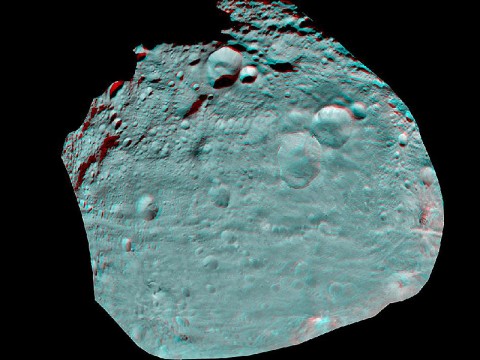 Washington, D.C. – The Dawn spacecraft has completed a graceful spiral into the first of four planned science orbits during the spacecraft’s yearlong visit to Vesta. The spacecraft started taking detailed observations on August 11th at 9:13am PDT (12:13am EDT), which marks the official start of the first science-collecting orbit phase at Vesta, also known as the survey orbit.
Washington, D.C. – The Dawn spacecraft has completed a graceful spiral into the first of four planned science orbits during the spacecraft’s yearlong visit to Vesta. The spacecraft started taking detailed observations on August 11th at 9:13am PDT (12:13am EDT), which marks the official start of the first science-collecting orbit phase at Vesta, also known as the survey orbit.
Survey orbit is the initial and highest orbit, at roughly 1700 miles (2700 kilometers) above the surface, which will provide an overview or “big picture” perspective of the giant asteroid.

The survey phase is planned to last 20 days. Each orbit takes almost three days, which will provide the spacecraft seven trips around Vesta. After survey orbit, Dawn will resume thrusting, taking about a month to spiral down gently to its next science orbit for an even closer view. That orbit, known as High Altitude Mapping Orbit, or HAMO, begins in late September. Dawn will spend about a month in HAMO, circling around Vesta in half a day, rather than three. Dawn will orbit more than 60 times during HAMO, allowing the camera to fully map the illuminated portion of Vesta at even higher resolution, and enable the science team to generate stereo images.
For more information about Dawn, visit: http://www.nasa.gov/dawn and http://dawn.jpl.nasa.gov .
Dawn launched in September 2007 and arrived at Vesta in July 2011. Following a year at Vesta, the spacecraft will depart in July 2012 for Ceres, where it will arrive in 2015. Dawn’s mission to Vesta and Ceres is managed by the Jet Propulsion Laboratory, Pasadena, CA, for NASA’s Science Mission Directorate in Washington. JPL is a division of the California Institute of Technology in Pasadena. Dawn is a project of the directorate’s Discovery Program, managed by NASA’s Marshall Space Flight Center in Huntsville, AL.
UCLA is responsible for overall Dawn mission science. Orbital Sciences Corp. in Dulles, VA, designed and built the spacecraft. The German Aerospace Center, the Max Planck Institute for Solar System Research, the Italian Space Agency and the Italian National Astrophysical Institute are international partners on the mission team.


